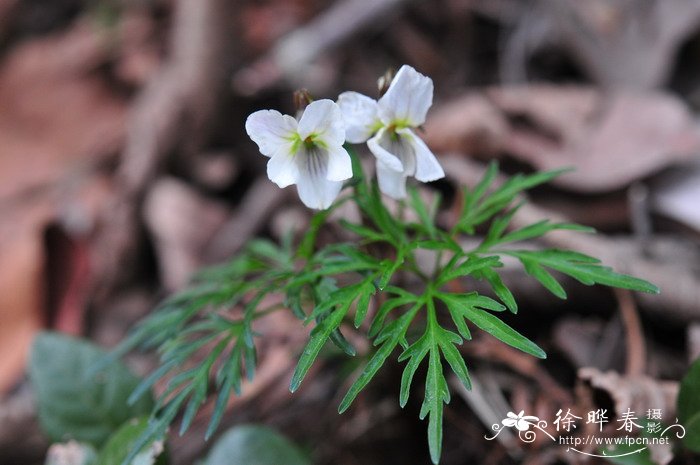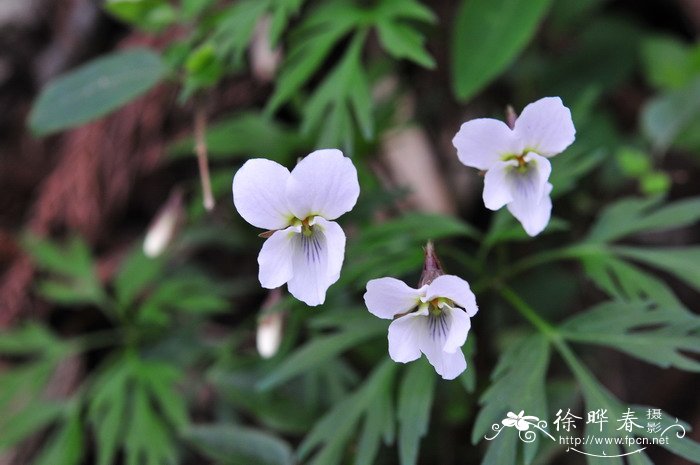南山堇菜Viola chaerophylloides
中文名(Chinese Name):南山堇菜
学名(Scientific Name):Viola chaerophylloides (Regel) W. Beck.
英文名(English Common Name):
别名(Chinese Common Name):胡堇菜
异名(Synonym):Viola dissecta var. chaerophylloides (Regel) Makino Viola napellifolia Nakai Viola pinnata var. chaerophylloides Regel Viola dentariifolia H. Boissieu Viola sieboldiana var. chaerophylloides (Regel) Nakai Viola albida var. chaerophylloides (Regel) F. Maek. Viola pinnata var. dissecta f. pedata Miq. Viola pinnata var. dissecta f. triphylla Miq.
科属(Family & Genus):堇菜科(Violaceae)堇菜属
形态特征(Description):多年生草本,无地上茎,花期较矮小,高4-20厘米,果期高可达30余厘米。根状茎直立,较短粗,长3-10毫米,被残存的托叶所包围,下部有3-6条较粗的淡黄色或白色的根。基生叶2-6枚,具长柄;叶片3全裂,裂片具明显的短柄,侧裂片2深裂,中央裂片2-3深裂,最终裂片的形状和大小变异幅度较大,卵状披针形、披针形、长圆形、线状披针形,边缘具不整齐的缺刻状齿或浅裂,有时深裂,先端钝或尖,两面无毛或上面和下面沿叶脉有短柔毛;叶柄在花期长3-9厘米,通常绿色,有时稍带淡紫色,无毛,有光泽,果期伸长,长可达20余厘米;托叶膜质,1/2以上与叶柄合生,宽披针形,先端渐尖,边缘具稀疏细齿和缘毛或全缘。花较大,花径2-2.5厘米,白色、乳白色或淡紫色,有香味;花梗通常呈淡紫色,无毛,有光泽,花期与叶等长或高出于叶,中部以下有2枚小苞片;小苞片线形或线状披针形,具极稀疏而细的小齿;萼片长圆状卵形或狭卵形,长10-14毫米,基部附属物发达,长4.5-6毫米,末端具不整齐的缺刻或浅裂,无毛,具3脉和膜质缘;花瓣宽倒卵形,上方花瓣长13-15毫米,宽约9毫米,侧方花瓣长约15毫米,宽约7毫米,里面基部有细须毛,下方花瓣有紫色条纹,连距长16-20毫米;距长而粗,长5-7毫米,直或稍下弯;花药长2.5-3毫米,下方雄蕊之距较细,长约5毫米,粗约1.5毫米;子房无毛,长约2毫米,花柱长约3毫米,基部稍膝曲,柱头两侧及后方有稍肥厚的缘边,中央部分微隆起,前方具明显的短喙,喙端具圆形柱头孔。蒴果大,长椭圆状,长1-1.6厘米,无毛,先端尖。种子多数,卵状,长约2.2毫米,直径约1.5毫米。花果期4-9月。
分布(Distribution):产东北、内蒙古、河北、山西、陕西、甘肃、青海、山东、江苏、安徽、浙江、江西、河南、湖北、四川,生于海拔1600米以下山地阔叶林下或林缘、溪谷阴湿处、阳坡灌丛及草坡。朝鲜、日本、俄罗斯也有。
引自中国植物志英文版:FOC Vol. 13 Page 76, 93
Viola chaerophylloides (Regel) W. Becker, Bull. Herb. Boissier, sér. 2. 2: 856. 1902.
南山堇菜 nan shan jin cai | Violaceae | Viola
Herbs perennial, acaulescent, dwarf at anthesis, 4-20 cm tall, to more than 30 cm tall at fruiting. Rhizome erect, short, 3-10 mm, stout, surrounded by remains of stipules, with 3-6 robust yellowish or white roots. Basal leaves 2-6, long petiolate; stipules over 1/2 adnate to petioles, broadly lanceolate, membranous, margin sparsely denticulate and ciliate or entire, apex acuminate; petioles 3-9 cm at anthesis, usually green, sometimes purplish, glabrous, nitid, elongated at fruiting to more than 20 cm; leaf blade glabrous on both surfaces or pubescent along veins, 3-sect, segments shortly stipitate, lateral segments deeply 2-fid, central segment deeply 2- or 3-fid, terminal lobes highly variable in shape and size, ovate-lanceolate, lanceolate, oblong, or linear-lanceolate, margin irregularly dentate or shallowly divided, sometimes triparted to pinnatiparted or 3-lobed, apex obtuse or acute. Flowers white, creamy-white, or purplish, large, 2-2.5 cm in diam., fragrant; pedicels usually purplish, nitid, subequaling or exceeding leaves at anthesis, glabrous, 2-bracteolate above middle; bracteoles linear or linear-lanceolate, margin very remotely and minutely denticulate. Sepals oblong-ovate or narrowly ovate, 1-1.4 cm, basal auricles developed, 4.5-6 mm, glabrous, 3-veined, margin membranous, apex irregularly emarginate or shallowly divided. Petals broadly obovate, upper petals 1.3-1.5 cm × ca. 9 mm, lateral ones ca. 1.5 × 0.7 cm, sparsely bearded, anterior one purple-striate, 1.6-2 cm (spur included); spur long, 5-7 mm, stout, straight or slightly curved downward. Anthers 2.5-3 mm, spur of anterior 2 stamens ca. 5 mm, slender, ca. 1.5 mm in diam. Ovary ca. 2 mm, glabrous; styles ca. 3 mm, base slightly geniculate; stigmas slightly thickly margined on lateral sides and abaxially, slightly raised in central part, shortly beaked in front, with a rounded stigma hole at tip of beak. Capsule narrowly ellipsoid, large, 1-1.6 cm, glabrous, apex acute. Seeds numerous, ovoid, ca. 2.2 mm, ca. 1.5 mm in diam.
Mixed forests, forest margins, shaded and moist places in stream valleys, thickets on sunny slopes, grassy slopes; below 2000 m. Anhui, Chongqing, Hebei, Henan, Hubei, Jiangsu, Jiangxi, Liaoning, Shandong, Zhejiang [Japan, Korea, SE Russia].


(责任编辑:徐晔春)
学名(Scientific Name):Viola chaerophylloides (Regel) W. Beck.
英文名(English Common Name):
别名(Chinese Common Name):胡堇菜
异名(Synonym):Viola dissecta var. chaerophylloides (Regel) Makino Viola napellifolia Nakai Viola pinnata var. chaerophylloides Regel Viola dentariifolia H. Boissieu Viola sieboldiana var. chaerophylloides (Regel) Nakai Viola albida var. chaerophylloides (Regel) F. Maek. Viola pinnata var. dissecta f. pedata Miq. Viola pinnata var. dissecta f. triphylla Miq.
科属(Family & Genus):堇菜科(Violaceae)堇菜属
形态特征(Description):多年生草本,无地上茎,花期较矮小,高4-20厘米,果期高可达30余厘米。根状茎直立,较短粗,长3-10毫米,被残存的托叶所包围,下部有3-6条较粗的淡黄色或白色的根。基生叶2-6枚,具长柄;叶片3全裂,裂片具明显的短柄,侧裂片2深裂,中央裂片2-3深裂,最终裂片的形状和大小变异幅度较大,卵状披针形、披针形、长圆形、线状披针形,边缘具不整齐的缺刻状齿或浅裂,有时深裂,先端钝或尖,两面无毛或上面和下面沿叶脉有短柔毛;叶柄在花期长3-9厘米,通常绿色,有时稍带淡紫色,无毛,有光泽,果期伸长,长可达20余厘米;托叶膜质,1/2以上与叶柄合生,宽披针形,先端渐尖,边缘具稀疏细齿和缘毛或全缘。花较大,花径2-2.5厘米,白色、乳白色或淡紫色,有香味;花梗通常呈淡紫色,无毛,有光泽,花期与叶等长或高出于叶,中部以下有2枚小苞片;小苞片线形或线状披针形,具极稀疏而细的小齿;萼片长圆状卵形或狭卵形,长10-14毫米,基部附属物发达,长4.5-6毫米,末端具不整齐的缺刻或浅裂,无毛,具3脉和膜质缘;花瓣宽倒卵形,上方花瓣长13-15毫米,宽约9毫米,侧方花瓣长约15毫米,宽约7毫米,里面基部有细须毛,下方花瓣有紫色条纹,连距长16-20毫米;距长而粗,长5-7毫米,直或稍下弯;花药长2.5-3毫米,下方雄蕊之距较细,长约5毫米,粗约1.5毫米;子房无毛,长约2毫米,花柱长约3毫米,基部稍膝曲,柱头两侧及后方有稍肥厚的缘边,中央部分微隆起,前方具明显的短喙,喙端具圆形柱头孔。蒴果大,长椭圆状,长1-1.6厘米,无毛,先端尖。种子多数,卵状,长约2.2毫米,直径约1.5毫米。花果期4-9月。
分布(Distribution):产东北、内蒙古、河北、山西、陕西、甘肃、青海、山东、江苏、安徽、浙江、江西、河南、湖北、四川,生于海拔1600米以下山地阔叶林下或林缘、溪谷阴湿处、阳坡灌丛及草坡。朝鲜、日本、俄罗斯也有。
引自中国植物志英文版:FOC Vol. 13 Page 76, 93
Viola chaerophylloides (Regel) W. Becker, Bull. Herb. Boissier, sér. 2. 2: 856. 1902.
南山堇菜 nan shan jin cai | Violaceae | Viola
Herbs perennial, acaulescent, dwarf at anthesis, 4-20 cm tall, to more than 30 cm tall at fruiting. Rhizome erect, short, 3-10 mm, stout, surrounded by remains of stipules, with 3-6 robust yellowish or white roots. Basal leaves 2-6, long petiolate; stipules over 1/2 adnate to petioles, broadly lanceolate, membranous, margin sparsely denticulate and ciliate or entire, apex acuminate; petioles 3-9 cm at anthesis, usually green, sometimes purplish, glabrous, nitid, elongated at fruiting to more than 20 cm; leaf blade glabrous on both surfaces or pubescent along veins, 3-sect, segments shortly stipitate, lateral segments deeply 2-fid, central segment deeply 2- or 3-fid, terminal lobes highly variable in shape and size, ovate-lanceolate, lanceolate, oblong, or linear-lanceolate, margin irregularly dentate or shallowly divided, sometimes triparted to pinnatiparted or 3-lobed, apex obtuse or acute. Flowers white, creamy-white, or purplish, large, 2-2.5 cm in diam., fragrant; pedicels usually purplish, nitid, subequaling or exceeding leaves at anthesis, glabrous, 2-bracteolate above middle; bracteoles linear or linear-lanceolate, margin very remotely and minutely denticulate. Sepals oblong-ovate or narrowly ovate, 1-1.4 cm, basal auricles developed, 4.5-6 mm, glabrous, 3-veined, margin membranous, apex irregularly emarginate or shallowly divided. Petals broadly obovate, upper petals 1.3-1.5 cm × ca. 9 mm, lateral ones ca. 1.5 × 0.7 cm, sparsely bearded, anterior one purple-striate, 1.6-2 cm (spur included); spur long, 5-7 mm, stout, straight or slightly curved downward. Anthers 2.5-3 mm, spur of anterior 2 stamens ca. 5 mm, slender, ca. 1.5 mm in diam. Ovary ca. 2 mm, glabrous; styles ca. 3 mm, base slightly geniculate; stigmas slightly thickly margined on lateral sides and abaxially, slightly raised in central part, shortly beaked in front, with a rounded stigma hole at tip of beak. Capsule narrowly ellipsoid, large, 1-1.6 cm, glabrous, apex acute. Seeds numerous, ovoid, ca. 2.2 mm, ca. 1.5 mm in diam.
Mixed forests, forest margins, shaded and moist places in stream valleys, thickets on sunny slopes, grassy slopes; below 2000 m. Anhui, Chongqing, Hebei, Henan, Hubei, Jiangsu, Jiangxi, Liaoning, Shandong, Zhejiang [Japan, Korea, SE Russia].
(责任编辑:徐晔春)
踩一下[0]

顶一下[0]